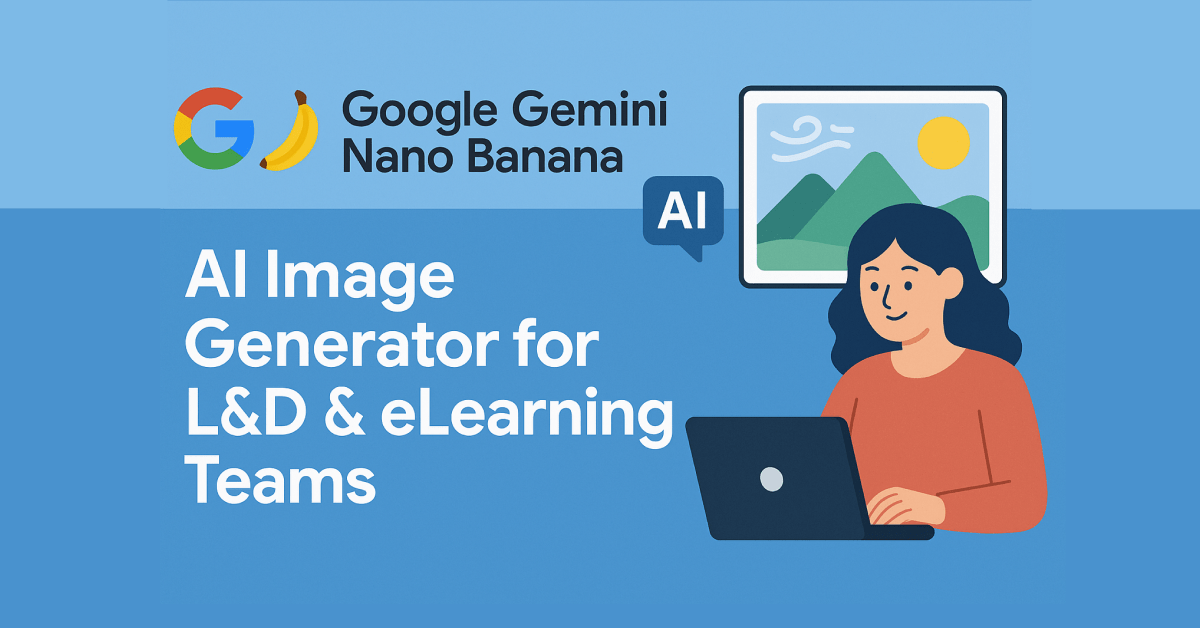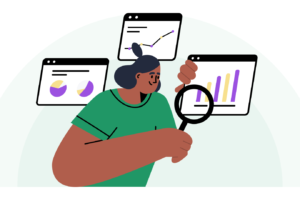
AI Image Generator for eLearning & L&D
Visuals are at the heart of modern learning—whether it’s compliance training, onboarding, or complex product walkthroughs. Yet creating high-quality, contextual and consistent imagery eats up budget and time. Enter Google Gemini’s “Nano Banana” (Gemini 2.5 Flash Image), a newly released image generator and natural-language editor. It doesn’t just create images—it edits existing ones with uncanny realism, maintains character likeness across scenarios, and blends multiple sources into a coherent output.
Download eBook: 25 AI Tools for L&D Success
For learning professionals, this means faster prototyping, more engaging courses, and scalable asset creation—without relying on stock photos or lengthy design cycles. Let’s dive into the key features, practical use cases, and real-world applications of Google Gemini’s Nano Banana—and explore how it can transform the way we design and deliver learning visuals.
Table Of Content
What Is Gemini Nano Banana?
“Nano Banana” is Google’s whimsical nickname for the Gemini 2.5 Flash Image model: a unified tool for both image generation (via Imagen 4) and fine-grained editing—a one-stop visual wizard.
It allows users to:
- Generate custom visuals from text prompts
- Edit and enhance existing images effortlessly
- Create responsive visuals optimized for multiple devices
- Integrate visuals into broader learning ecosystems
For L&D professionals, this means a streamlined way to design graphics, infographics, and illustrations without always relying on external design resources.
Why Do Visuals Matter in Learning
According to Mayer’s Cognitive Theory of Multimedia Learning, learners absorb information better when words are combined with relevant visuals. Images reduce cognitive overload and support dual coding, helping learners retain and recall information effectively.
In the world of learning and development, visuals aren’t just nice to have—they’re strategic necessities. Multiple studies affirm that well-crafted visuals significantly boost engagement, retention, and efficiency:
- Visuals can improve learning experience by up to 400%, helping learners grasp and retain complex material far more effectively through diagrams, infographics, and videos.
- eLearning boosts retention rates to 25%–60%, compared to only 8%–10% for traditional face-to-face training, enabling deeper learning with greater flexibility.
- Microlearning modules featuring strong visual content increase information retention by around 20% and typically achieve 80% completion rates, far higher than long-form learning formats.
- A key cognitive principle: The picture superiority effect —where images are more likely to be remembered than words—underscores the power of combining image and text for dual coding and deeper memory encoding.
Taken together, these figures reveal a clear truth: Visuals are central to modern instructional design. For instructional designers, visual designers, and eLearning developers, integrating Google’s Gemini “Nano Banana” (Gemini 2.5 Flash Image) isn’t just innovative—it’s a data-driven imperative for crafting engaging, memorable, and efficient learning experiences.
What Are the Benefits of Nano Banana for Designers?
How Does Google Gemini Nano Banana Empower Designers?
Designers today need speed, precision, and consistency—Nano Banana delivers all three, and more. Here’s how it transforms creative workflows:
- Faster Visual Creation
- Consistency in Branding & Characters
- Precision Edits, Minimal Effort
- Versatile Design for Multimedia
- Accessibility Through Automation
Nano Banana makes it possible to generate scenario-based illustrations for case studies, design infographics aligned with training goals and create consistent visuals that adhere to brand guidelines. By doing so, it ensures learning material is not just attractive but also instructionally sound.
Here are some of the benefits of Nano Banana:
- Faster Visual Creation: Say goodbye to stock photo hunting or manual editing. You can generate backgrounds, characters, and visuals tailored to your learning scenarios in just moments.
- Consistency in Branding & Characters: Perfect for any storyline or course series that requires consistent visuals—like recurring characters, branded settings, or maintainable styles over modules. Nano Banana nails likeness retention while flexibly editing attire or pose.
- Precision Edits, Minimal Effort: Need to remove a distracting background element or tweak part of an image? Local edits make it painless, precise, and photo-realistic.
- Versatile Design for Multimedia: From training decks to animations, Nano Banana supports seamless blending, compositing, and stylizing—perfect for mixed-media output.
- Accessibility Through Automation: With the Gemini API, you can automate visual generation tasks—auto-create scenario images or update them based on learner data or user inputs.
Core Visual Features: A Deep Dive in Nano Banana
Google’s Gemini models offer a robust suite of visual creation and editing features that are transforming the content development landscape.
- Text-to-Image Generation: The foundational capability of Gemini is its ability to create high-quality, original images from simple or complex text descriptions. The model’s strength lies in its deep language understanding, which allows it to produce more coherent results from descriptive paragraphs rather than a simple list of keywords. For L&D professionals, this means the ability to generate specific, purpose-driven visuals on demand.
- Image + Text Editing (Local Edits): Gemini’s updated editing capabilities allow for precise, conversational modifications to specific parts of an image. This feature is invaluable for tasks ranging from product mockups to customizing scene-based visuals for training. For instance, a user can prompt the model to “change the color of the sofa to a deep navy blue” or “add a stack of three books to the coffee table” within a pre-existing image. This removes the need for complex, time-consuming edits in separate software.
- Multi-Image to Image (Creative Composition): This advanced feature enables the fusion of two or more ideas into a single, cohesive visual. The model can blend elements, subjects, and styles from disparate concepts. A classic example involves a user providing an image of an astronaut and a separate image of a basketball court in a rainforest, then prompting Gemini to “show the astronaut dunking a basketball in this court”. This allows for the creation of imaginative and highly specific visual metaphors for complex topics.
- Consistent Character Design: This is a truly transformative feature for narrative-based learning. Gemini can maintain a character’s likeness across multiple image generations and edits within a single conversation. Instructional designers can now define a character with specific details in an initial prompt and then place that same character in new poses, lighting conditions, and environments in subsequent prompts. This capability is game-changing for creating visually cohesive, scenario-based training and branching narratives.
- Design and Appearance Adaptation: Beyond creating new images, Gemini can apply the style, texture, or aesthetic of one concept to another. This “style transfer” is a powerful tool for maintaining brand consistency or adapting visuals to a specific tone, such as rendering a photorealistic image of a subject in the style of an architectural drawing or a minimalist infographic.
- High-Fidelity Text Rendering: A significant advancement over earlier generative models, Gemini can accurately render legible and well-placed text within images. This capability is critical for L&D, as it enables the creation of logos, diagrams, and posters with text elements that are not garbled or misspelled.
Hands-On with Google Gemini’s Nano Banana
Let me walk you through my hands-on experience with Nano Banana, showing you exactly how I used it, step by step, with screenshots to guide the way
Step 1: Generating Your First Visual
I started with a compliance training scenario.
Prompt: “A realistic illustration of a factory worker following safety procedures” with the generated output beside it.

Output

Within seconds, Nano Banana generated a clean, context-rich image. For compliance training, this aligns perfectly with Mayer’s Multimedia Principle, pairing text-based instructions with visuals for improved comprehension.
Step 2: Exploring Image Creation Styles
Here’s where the fun begins — the same prompt can take on completely different tones depending on the style.
|
Cinematic photo |
Anime-style character |
|
Cartoon-style illustration |
Minimalist flat-design |
- Realism → Great for accuracy (compliance, technical training).
- Minimalism → Perfect for microlearning (focus, clarity).
- Cartoon/Anime → Adds fun for gamification or soft skills.
- Cinematic → Engages learners in storytelling (leadership, culture).
Instructional Tip: Match the style to your objective. Use Realism to reduce ambiguity, or Cartoon to make dry topics approachable.
Step 3: Editing and Customizing Visuals
Sometimes the generated image is almost perfect — but you want to tweak it. Nano Banana’s editing tools make this easy.
|
Before |
After |
With just a few clicks, I changed the background color. Similarly, you can update the context of the image — for example, replacing outdated paper systems with a modern digital setup — or customize it in any way to meet your requirements.
Experimenting with Nano Banana firsthand showed me how quickly it can cut design time, reduce reliance on stock photography, and keep visuals aligned with instructional design principles. For me, Nano Banana doesn’t just make content prettier — it makes learning clearer, more engaging, and more learner-centered.
What Are the Different Image Creation Styles for eLearning
In today’s digital-first world, visuals are not just supporting elements — they are the foundation of engaging learning experiences. Here’s an overview to image creation styles you can leverage in your next project, with practical Nano Banana prompts and explanations:
1. Artistic Styles: Setting the Tone of Learning
These styles influence how learners emotionally respond to the content. They can make material feel serious, reflective, or imaginative.
- Realism – Captures real-life accuracy, best for compliance, medical, or technical training where precision matters. Learners feel grounded in reality.
Prompt: “A realistic illustration of a doctor demonstrating proper handwashing in a hospital setting.” - Impressionism – Soft, expressive brushwork ideal for topics like leadership or wellness that need a reflective tone. It creates a calming atmosphere.
Prompt: “Impressionist painting of a leader guiding a team under a sunrise, soft brush strokes.” - Surrealism – Blends imagination with reality, great for scenario-based training where abstract ideas (like ethics or innovation) need visualization.
Prompt: “Surreal image of a workplace meeting with floating clocks symbolizing time management.”
- Minimalism – Clean and simple, minimizing distraction for microlearning or quick reference modules. It directs attention to essentials.
Prompt: “Minimalist icon set representing teamwork and communication in flat design.” - Pop Art/Graffiti – Bold, vibrant, youth-oriented, often useful in onboarding or programs where energy and excitement are needed.
Prompt: “Pop art style illustration of a new hire celebrating first day at work, bright colors.”
Pro Tip: Artistic styles shape the mood — use Realism for credibility, Minimalism for clarity, Surrealism for creativity.
2. Photographic Styles: Bringing Authenticity
Photography provides realism and relatability, helping learners connect content to real-world contexts.
- Portraits – Showcase leaders, role models, or customer personas. Builds trust and human connection.
Prompt: “Professional headshot of a confident sales manager in business attire.” - Landscape – Great for environmental or safety training, offering a big-picture context.
Prompt: “Wide photo of a construction site with workers in safety gear.” - Macro – Focuses on details for technical training or product-based training. Sharpens learner observation.
Prompt: “Macro photo of a machine gear being lubricated, highly detailed.” - Black & White – Strips away distraction, encouraging reflection and storytelling.
Prompt: “Black and white photo of an employee reflecting in a quiet workspace.” - Cinematic – Story-driven style with dramatic lighting for immersive narratives.
Prompt: “Cinematic photo of a team brainstorming in a modern office, strong depth of field.”
Pro Tip: Choose photography when authenticity is key to credibility and learner trust.

25 AI Tools for L&D That Make Learning Stick
A curated guide to the smartest AI tools for:
- Writing
- Visual Design
- Voice & Narration
- Interactivity
- And More
3. Illustration & Cartoon Styles: Making Learning Fun
These styles simplify complexity, reduce intimidation, and make dry content approachable.
- Cartoon/Comic – Adds humor and fun, lightening up compliance or policy training.
Prompt: “Comic-style illustration of employees learning cyber security basics.” - Anime/Manga/Chibi – Culturally aligned, appealing to youth-focused or Asian audiences. Increases relatability.
Prompt: “Anime-style character learning teamwork skills, expressive eyes.” - 3D Pixar-Style – Warm, animated look, excellent for onboarding or customer service scenarios. Builds empathy.
Prompt: “3D Pixar-style character onboarding at a new company with a laptop.” - Flat/Isometric – Modern, clean, easy to integrate into infographics or explainer videos. Keeps focus on clarity.
Prompt: “Isometric flat design illustration of employees collaborating in a virtual workspace.” - Pixel Art – Nostalgic and retro, perfect for gamification badges or progress trackers. Appeals to learners through playfulness.
Prompt: “Pixel art badge for completing time management training.”
Pro Tip: Use cartoon styles to make challenging topics memorable and enjoyable.
4. Design & Conceptual Styles: Enhancing Instructional Strategy
Conceptual visuals transform abstract ideas into digestible images that align with instructional goals.
- Infographics – Condense large amounts of information into visual form. Perfect for performance support.
Prompt: “Infographic showing the 5 stages of project management with icons.” - Collage/Montage – Juxtaposes multiple visuals to emphasize diversity, inclusion, or blended learning.
Prompt: “Collage of employees from different countries working together online.” - Fantasy/Sci-Fi/Steampunk – Stimulates imagination in role-plays or creative training.
Prompt: “Steampunk-themed office for leadership role-play simulation.” - Concept Art – Helps prototype immersive VR/AR or gamified learning.
Prompt: “Concept art of a futuristic classroom with holographic teachers.” - Typography Art – Uses text as visuals for impact. Great for motivational or microlearning nuggets.
Prompt: “Typography-based poster with the word ‘RESILIENCE’ shaped like a mountain.”
Pro Tip: Conceptual visuals make abstract concepts tangible, aiding comprehension.
5. Digital & AI Styles: Future-Ready Learning Design
Digital and AI-powered visuals offer scalability, speed, and modernity.
- Photo-realistic AI Render – Ideal for training simulations that need realism without photography costs.
Prompt: “Photo-realistic render of a factory worker using machinery safely.” - Stylized AI Render – Balances abstraction with engagement for soft skills.
Prompt: “Stylized render of two employees shaking hands in a colorful abstract office.” - Neon/Glitch/Vaporwave – Energetic, digital aesthetics suited for gamified or cybersecurity topics.
Prompt: “Vaporwave neon graphic of a hacker typing on a glowing laptop.” - Low Poly – Simplified 3D look, lightweight for mobile-first delivery.
Prompt: “Low poly 3D office with employees collaborating at desks.” - Generative Abstract – Creates inspiring, thought-provoking visuals, perfect for brainstorming sessions.
Prompt: “Generative abstract art symbolizing creative thinking with bright flowing patterns.”
Pro Tip: AI-generated styles can reduce design time by 60% while offering endless variety.
Practical L&D Use Cases
|
Scenario |
How Nano Banana Fits |
|
Custom course thumbnails |
Generate relevant, branded visuals instantly |
|
Character development across courses |
Retain likeness (style, pose) while tweaking scenario or clothing |
|
Scenario manipulation |
Remove irrelevant background objects; focus learner attention easily |
|
Localization |
Replace backgrounds/text/language-specific elements to adapt courses across regions |
|
Branching scenarios & avatars |
Auto-generate multiple character visual variations for adaptive storytelling |
Getting Started: Tips for L&D Designers
- Play in Gemini app or AI Studio first to understand capabilities and refine your prompt-to-output process.
- Experiment with a stable persona or character—let Nano Banana edit clothing, expression, or accessories while preserving identity.
- Leverage localization possibilities: swap multilingual text, region-appropriate visuals, or cultural references seamlessly.
- Batch-create assets via API: e.g., generate scenario variants for branching assessments.
- Combine with manual review: have a human designer tweak output for tone, clarity, or branding perfection.
Considerations & Best Practices
- Avoid over-reliance: AI-generated visuals still benefit from a human touch—especially for empathy, cultural nuance, accessibility (alt text, contrast), and instructional efficacy.
- Prompt finesse matters: Clarity and specificity in prompts make all the difference. Think about perspective, lighting, character mood, and style.
- Stay ethical: Be mindful of potential biases or misrepresentations, especially around identity preservation and cultural likenesses.
- Version management: Keep track of prompt-output pairs—especially across course updates or iterations.
Tips from My Experience
Along the way, I learned a few tricks:
- Reuse prompts – Save your best ones as templates for consistency.
- Iterate fast – Don’t settle for the first result; refine until it fits your learning goal.
- Think accessibility – Add alt text to every generated image.
- Match style with intent – Always tie visuals back to learning objectives.
The Future of AI-Driven Learning Visuals
Nano Banana reflects the future: visual content that’s not just dynamic but responsive, adaptable, and context-aware. Combined with other AI tools for text, voice, and interactivity, it’s a powerful enabler of more immersive, scalable, and personalized learning.
Google Gemini’s Nano Banana is more than a novelty—it’s a practical, powerful tool for modern L&D professionals who want to rapidly create, iterate, and tailor high-quality visuals. Whether it’s consistent characters, localized imagery, or branching-scenario assets, Nano Banana positions you to work faster, smarter, and more creatively. The future of L&D will be built on a suite of AI-powered tools that simplify design, speed up development, and make learning truly stick. If you’re curious to explore beyond visuals and discover the full potential of AI in corporate training, don’t miss our eBook and uncover a curated list of tools for design, development, delivery, and beyond. Your guide to building smarter, faster, and more engaging learning experiences.





.png?width=350&height=350&name=Editing-and-Customizing-Visuals-in-Nano-Banana%20(1).png)
.png?width=350&height=350&name=Editing-and-Customizing-Visuals-in-Nano-Banana%20(2).png)




